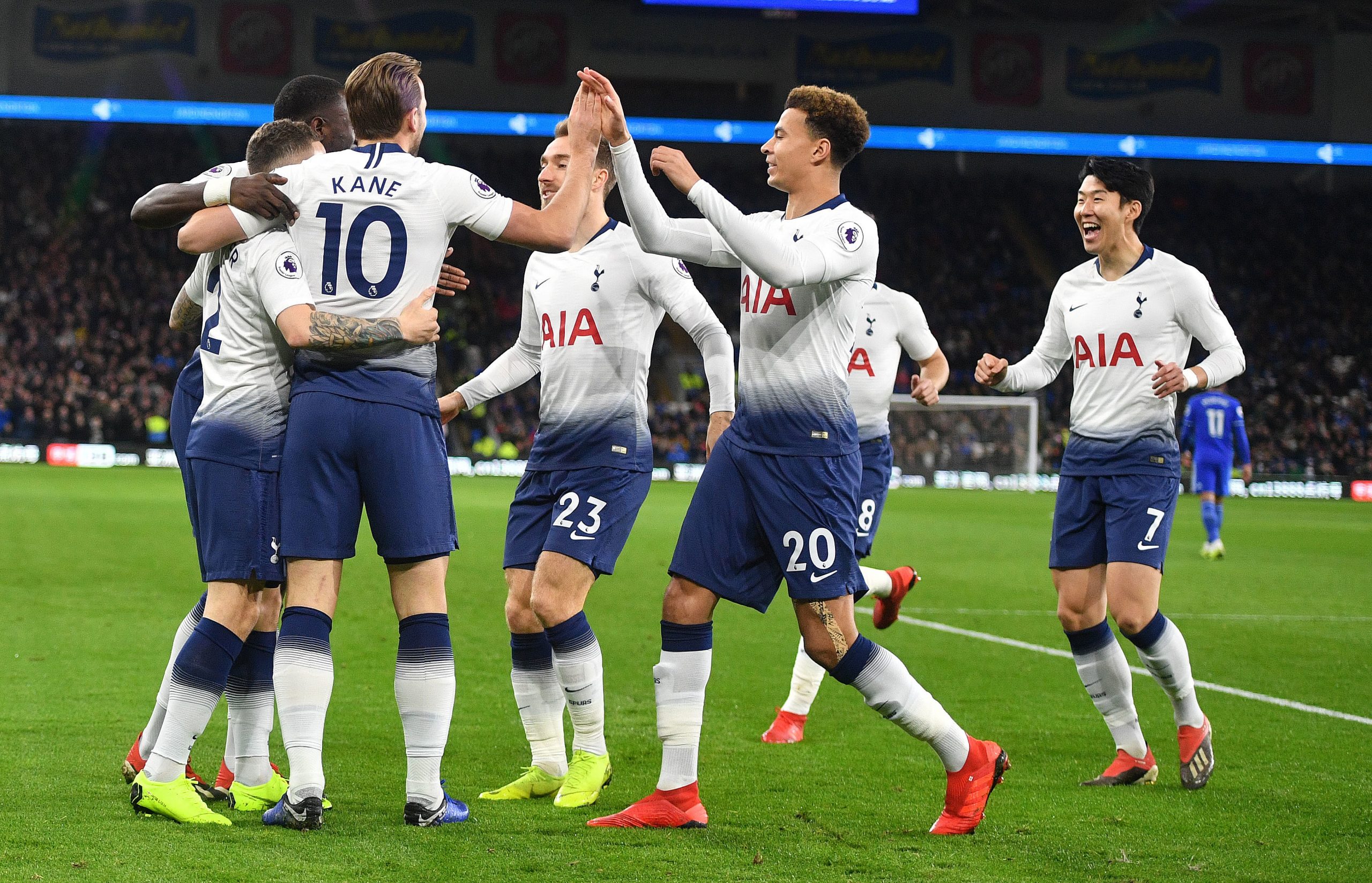This article was co-authored by @GraceOnFootball and @MoeSquare. No matter what the numbers have said this season, Spurs have just kept picking up wins. Their 48 points from 21 games so far is eight better than last season and the best the club have achieved at this stage since Mauricio Pochettino’s arrival. The curious thing, then, is that most of the statistical indicators tell us that Spurs have been kind of underwhelming. When looking at the expected goals trendlines, it becomes very clear that things are down notably from last season in both attack and defense. 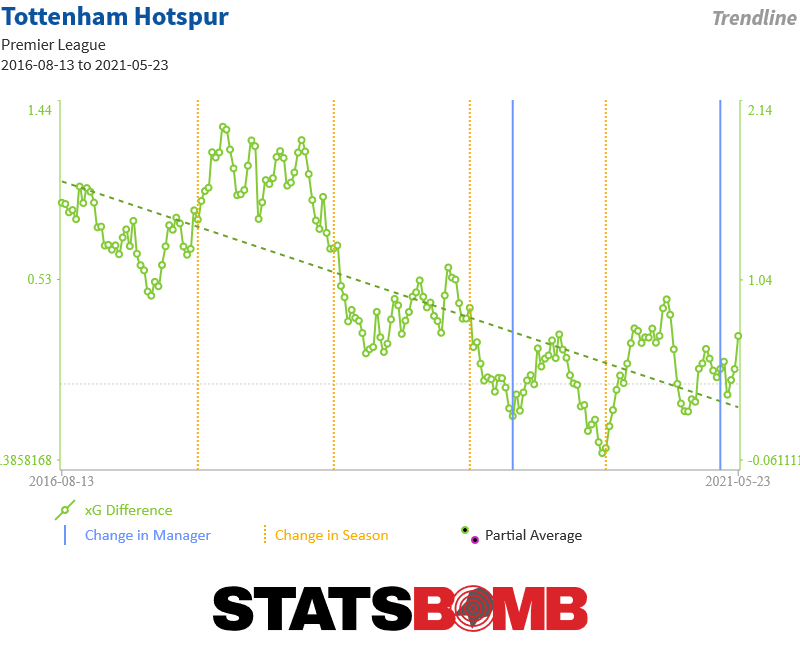 And yet the results keep coming. When looking at both shot maps below, we can see that Tottenham are really over-performing xG on the attacking side (left), while seeing a slight beating of expectations on the defensive end (right).
And yet the results keep coming. When looking at both shot maps below, we can see that Tottenham are really over-performing xG on the attacking side (left), while seeing a slight beating of expectations on the defensive end (right). 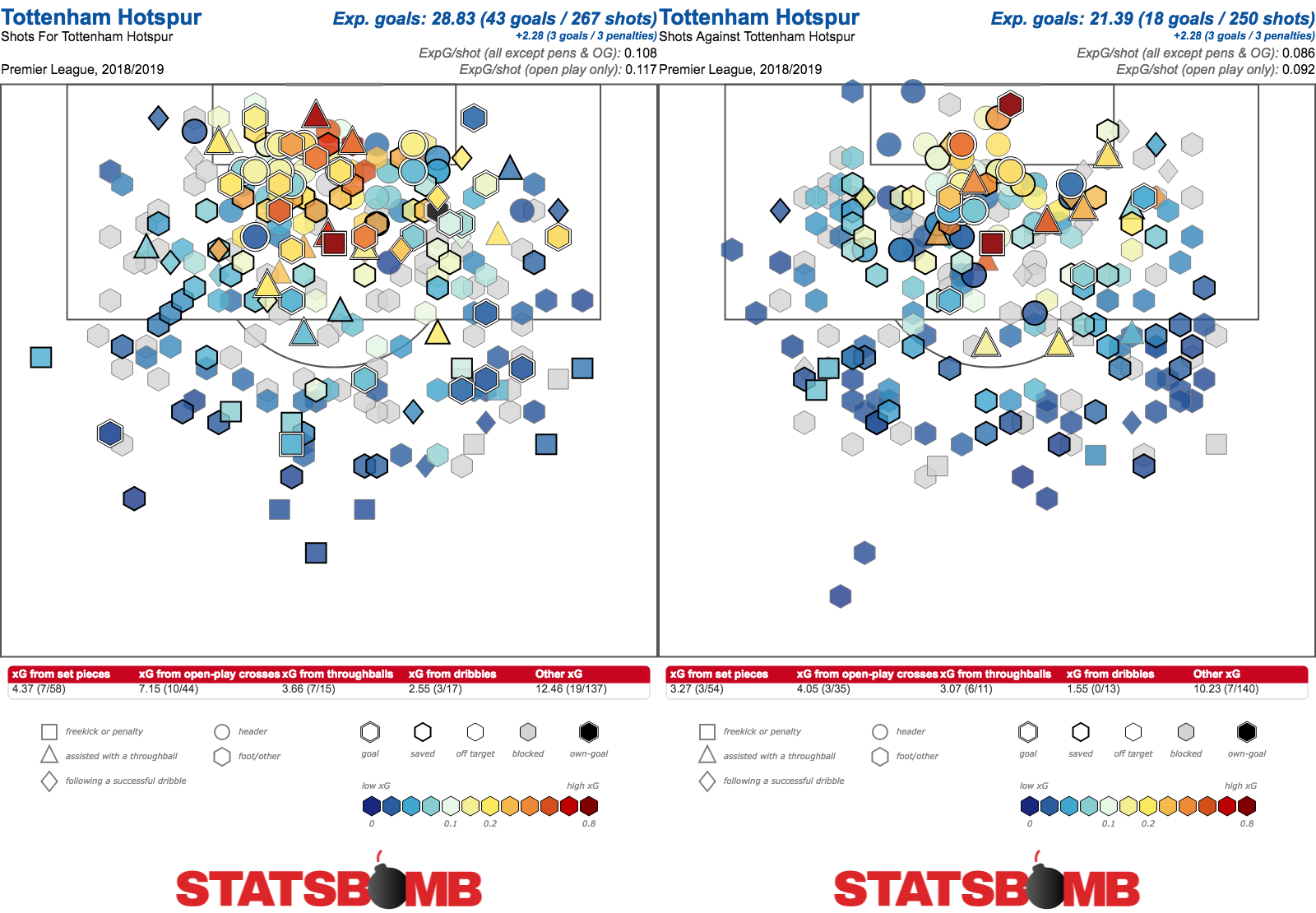 The extent to which this is repeatable remains an open question. The evidence we have suggests Pochettino’s Spurs have a habit of beating the metrics, so there may be something here. What has never been clear, though, is whether Tottenham’s overperformance in past years has been down to tactical choices or simply the combination of above average finishers (particularly Harry Kane and Son Heung-min, while Dele Alli has had good finishing runs at times) matched with Hugo Lloris’ excellent goalkeeping. What does seem apparent, though, is that Spurs do not generally beat xG to the extent that they are right now. When looking at last season’s data, they only overperformed on the attacking side by 12% in 2017/18, whereas right now they are doing so by 49%. That’s a lot. So have Spurs at least made tactical changes that might account for some of the difference? Quite possibly. As Michael Caley’s research has shown, Tottenham place a much greater emphasis than other top six sides this season on attacking from very short moves. Similarly, StatsBomb’s data have Spurs second in the league for counter attacking shots (taken within 15 seconds of a possession that originates in the opposition’s own half), behind only Leicester and ahead of all other top six clubs. Tottenham are certainly doing things differently this year, though it’s still hard not to feel as though they have had the rub of the green in terms of finishing. Tactically, the big shift in the last few months has been toward the diamond system. Harry Winks has been the deepest midfielder (though Eric Dier had also played this role before his current injury), with Christian Eriksen and Moussa Sissoko in shuttling roles slightly advanced of him and Alli playing as the number ten behind two strikers, usually Son and Kane. Alli in particular seems to be thriving in this role, giving him the licence to find space with his intelligent movement. The 3-1 victory over Chelsea, in which he nullified Jorginho while contributing a goal and an assist, remains a highlight. Meanwhile, Pochettino has finally found use for Sissoko’s fairly limited skillset in a shuttler role getting up and down the pitch. On the other hand, Eriksen has had to become a much more active defender in this midfield role. While that is certainly something he is capable of, the more attacking positions he took up in previous years allowed him to be a better involved playmaker along with scoring and assisting more often. Eriksen certainly hasn’t been bad this season, far from it, but when comparing his radars to last season it does feel as though a chunk of his game has been sacrificed on the attacking side.
The extent to which this is repeatable remains an open question. The evidence we have suggests Pochettino’s Spurs have a habit of beating the metrics, so there may be something here. What has never been clear, though, is whether Tottenham’s overperformance in past years has been down to tactical choices or simply the combination of above average finishers (particularly Harry Kane and Son Heung-min, while Dele Alli has had good finishing runs at times) matched with Hugo Lloris’ excellent goalkeeping. What does seem apparent, though, is that Spurs do not generally beat xG to the extent that they are right now. When looking at last season’s data, they only overperformed on the attacking side by 12% in 2017/18, whereas right now they are doing so by 49%. That’s a lot. So have Spurs at least made tactical changes that might account for some of the difference? Quite possibly. As Michael Caley’s research has shown, Tottenham place a much greater emphasis than other top six sides this season on attacking from very short moves. Similarly, StatsBomb’s data have Spurs second in the league for counter attacking shots (taken within 15 seconds of a possession that originates in the opposition’s own half), behind only Leicester and ahead of all other top six clubs. Tottenham are certainly doing things differently this year, though it’s still hard not to feel as though they have had the rub of the green in terms of finishing. Tactically, the big shift in the last few months has been toward the diamond system. Harry Winks has been the deepest midfielder (though Eric Dier had also played this role before his current injury), with Christian Eriksen and Moussa Sissoko in shuttling roles slightly advanced of him and Alli playing as the number ten behind two strikers, usually Son and Kane. Alli in particular seems to be thriving in this role, giving him the licence to find space with his intelligent movement. The 3-1 victory over Chelsea, in which he nullified Jorginho while contributing a goal and an assist, remains a highlight. Meanwhile, Pochettino has finally found use for Sissoko’s fairly limited skillset in a shuttler role getting up and down the pitch. On the other hand, Eriksen has had to become a much more active defender in this midfield role. While that is certainly something he is capable of, the more attacking positions he took up in previous years allowed him to be a better involved playmaker along with scoring and assisting more often. Eriksen certainly hasn’t been bad this season, far from it, but when comparing his radars to last season it does feel as though a chunk of his game has been sacrificed on the attacking side. 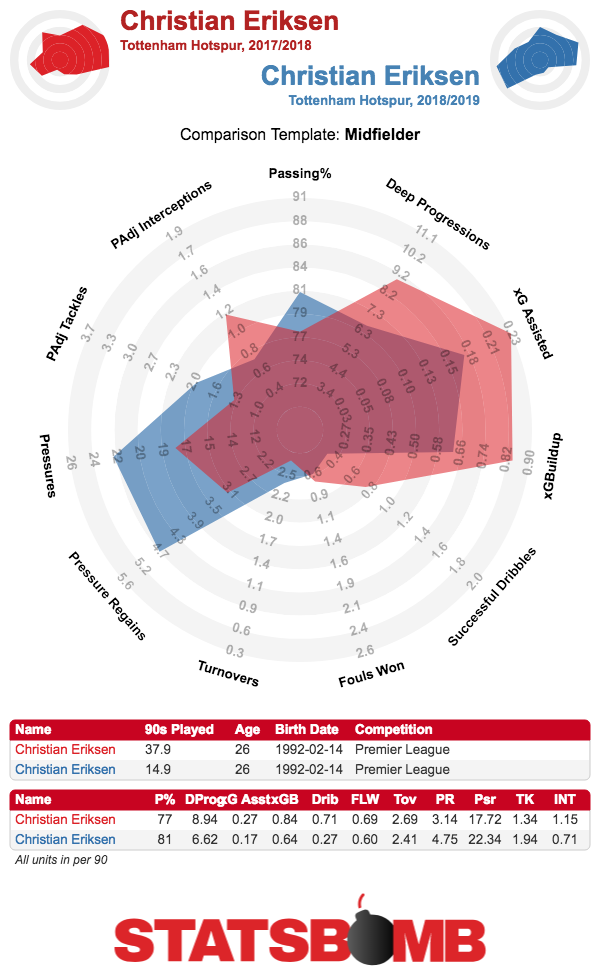 Winks has found himself with a similar problem. Though he remains a decent distributor, his ball progression abilities are significantly constrained as he sits in front of the back four. As the season has gone on, his defensive pressure numbers have gradually risen while his deep progressions and other numbers have fallen. When comparing this season to last, it’s obvious that Spurs are using him differently, but not necessarily more effectively.
Winks has found himself with a similar problem. Though he remains a decent distributor, his ball progression abilities are significantly constrained as he sits in front of the back four. As the season has gone on, his defensive pressure numbers have gradually risen while his deep progressions and other numbers have fallen. When comparing this season to last, it’s obvious that Spurs are using him differently, but not necessarily more effectively. 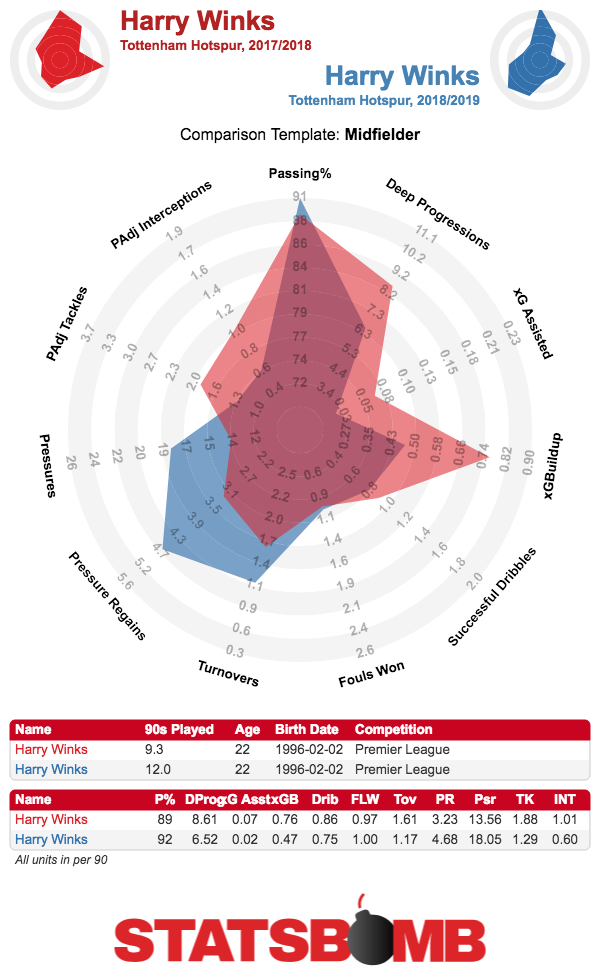 That so much has been shuffled around in midfield is quite obviously an attempt from Pochettino to mitigate the issue that they didn’t buy anyone there. In the 2015-16 season, Spurs could rely on the partnership of Dier and Mousa Dembele, with Dier offering a solid job as a holding player relying on positional sense while Dembele was a genuine unicorn of a player, combining a great defensive work rate with a unique ability to move the ball through midfield and evade pressure. In the summer of 2016, the club added Victor Wanyama, a destructive defensive midfielder who gave Tottenham excellent midfield depth. Fast forward to 2019 and both Wanyama and Dembele have suffered serious physical declines making them no longer at all reliable. That Dembele is reportedly set to leave Spurs hastens the need for reinforcements, but is hardly a surprise. Dier, meanwhile, has not yet made the leap from a talented young player to a key midfielder with his 25th birthday around the corner. The Englishman remains a solid option, but this may be all that is to be expected going forward. To say that Spurs’ midfield is in need of a shake up is an understatement. This should be the first area of the pitch that Pochettino and chairman Daniel Levy look to invest in. Questions also remain at fullback. Pochettino has earned himself a reputation as the “full back whisperer”, getting the best form of Luke Shaw and Calum Chambers’ careers at Southampton then helping Kyle Walker and Danny Rose become top tier players at Spurs. Currently his preferred pair are Kieran Trippier and Ben Davies, and it’s hard to argue that he’s not getting the maximum out of them, but there are simply deficiencies to their game. Trippier is certainly a strong attacker, being able to provide an attacking outlet with his forward runs while also putting in high quality deliveries into the box. The defensive side of his game, however, has its issues. As James Yorke wrote for StatsBomb back in September, the right back area has been a consistent source of conceding chances for Spurs. To make matters worse, this only seems to occur when Trippier starts. His backup Serge Aurier appears more solid in the numbers, but his rash performances to the eye have seen Pochettino reluctant to trust the Ivorian. Over on the left, Ben Davies is a solid defender and strong in the air, leading to occasional games at center back, but is merely an adequate attacker, while Rose remains much more adventurous but seems to be struggling to maintain a high level of fitness. Academy graduate Kyle Walker-Peters is an option on both sides, but his lack of game time suggests Pochettino simply isn’t convinced. While Spurs have solid pieces, none of the full back options excel on both sides of the ball. It’s clear that Spurs have holes that need fixing on the squad, and those holes are large enough that it inhibits them from being able to contend domestically and in continental football. Though they have the top end talent to compete against most, it’s just not feasible to mask the frailties that they have in certain positions over a 10 month marathon. Fixing those holes in the summer can be a struggle on its own, and that struggle gets amplified in the January window.
That so much has been shuffled around in midfield is quite obviously an attempt from Pochettino to mitigate the issue that they didn’t buy anyone there. In the 2015-16 season, Spurs could rely on the partnership of Dier and Mousa Dembele, with Dier offering a solid job as a holding player relying on positional sense while Dembele was a genuine unicorn of a player, combining a great defensive work rate with a unique ability to move the ball through midfield and evade pressure. In the summer of 2016, the club added Victor Wanyama, a destructive defensive midfielder who gave Tottenham excellent midfield depth. Fast forward to 2019 and both Wanyama and Dembele have suffered serious physical declines making them no longer at all reliable. That Dembele is reportedly set to leave Spurs hastens the need for reinforcements, but is hardly a surprise. Dier, meanwhile, has not yet made the leap from a talented young player to a key midfielder with his 25th birthday around the corner. The Englishman remains a solid option, but this may be all that is to be expected going forward. To say that Spurs’ midfield is in need of a shake up is an understatement. This should be the first area of the pitch that Pochettino and chairman Daniel Levy look to invest in. Questions also remain at fullback. Pochettino has earned himself a reputation as the “full back whisperer”, getting the best form of Luke Shaw and Calum Chambers’ careers at Southampton then helping Kyle Walker and Danny Rose become top tier players at Spurs. Currently his preferred pair are Kieran Trippier and Ben Davies, and it’s hard to argue that he’s not getting the maximum out of them, but there are simply deficiencies to their game. Trippier is certainly a strong attacker, being able to provide an attacking outlet with his forward runs while also putting in high quality deliveries into the box. The defensive side of his game, however, has its issues. As James Yorke wrote for StatsBomb back in September, the right back area has been a consistent source of conceding chances for Spurs. To make matters worse, this only seems to occur when Trippier starts. His backup Serge Aurier appears more solid in the numbers, but his rash performances to the eye have seen Pochettino reluctant to trust the Ivorian. Over on the left, Ben Davies is a solid defender and strong in the air, leading to occasional games at center back, but is merely an adequate attacker, while Rose remains much more adventurous but seems to be struggling to maintain a high level of fitness. Academy graduate Kyle Walker-Peters is an option on both sides, but his lack of game time suggests Pochettino simply isn’t convinced. While Spurs have solid pieces, none of the full back options excel on both sides of the ball. It’s clear that Spurs have holes that need fixing on the squad, and those holes are large enough that it inhibits them from being able to contend domestically and in continental football. Though they have the top end talent to compete against most, it’s just not feasible to mask the frailties that they have in certain positions over a 10 month marathon. Fixing those holes in the summer can be a struggle on its own, and that struggle gets amplified in the January window.
Midfield
One of the drawbacks of Tottenham’s inability to acquire young midfielders over the past couple of years is that now they're out of margin for error. If Tottenham had better success in finding a young midfielder or two in previous windows, they could be eased into the first team squad and eventually take the reigns from the incumbent. They don’t have that luxury now. Victor Wanyama has largely not played these past two seasons due to injury, Moussa Sissoko is what he is at this point despite a nice stretch of games recently, and Mousa Dembele is past his peak as a great two-way midfielder. That Tottenham have still been successful with a midfield that’s largely been kept together with duct tape is pretty remarkable. Tottenham just don’t need young midfielders, but they need young midfielders who can come in and be net-positive contributors right away. Given that Tottenham are dealing with the finances of their new stadium, it means they have to be more strategic when targeting young talents. Another issue that Tottenham have to work around is the difficulty of finding someone to fulfill the role that Mousa Dembele performed, because Dembele was such a unique player during his peak that it’s hard to get a young midfielder who is an adequate replacement. It’s why Tanguy N’Dombele would be such a clean fit. He has the intersection of defensive instincts, athleticism and dynamic passing, but with N’Dombele’s own ascension into the bracket of elite young talents in European football and Lyon’s participation in the CL knockout stage, his price range has gotten so high that he’s no longer a realistic target. Tottenham could try and still look for young midfielders who possess the ceiling of a mobile destroyer and high level passer, but have less certainty regarding present value. Ibrahim Sangare has the upside that Tottenham would be interested in, but he might be a couple of years away from being able to regularly contribute to a top Premier League club given he still has some room for growth in his passing abilities. Sander Berge is another option that’s been gaining some buzz, but it’s fair to wonder how quickly he would adjust from the level of competition in Belgium if asked to make the large step up to the Premier League. This isn’t to say that either Sangare or Berge couldn’t come in and be awesome immediately, but that the likelihood of that happening is not all that high. They're both young players who perhaps don’t quite thread the needle of providing present performance and having future value. At the very least in the short term, it probably would be easier to find someone who can replace what Victor Wanyama brought when he was healthy and be able to patrol the midfield defensively to provide cover for Harry Winks. Santiago Caseres is an interesting candidate because his defensive output has been impressive, albeit it’s been on a Villarreal side that has been a major disappointment this season.  Caseres has certainly done well in transitioning into a top five league from Argentina, playing with the same high level of intensity defensively that made him a household name in Argentina. His passing to this point has been more towards the cautious end of the spectrum than one who is constantly looking to open up the opposition. This isn’t a bad thing since he plays on a squad that includes Pablo Fornals and Santi Cazorla, so the playmaking burden is dealt with elsewhere. While Caseres will more often recycle possession, he’s not a Francis Coquelin type who hinders his side during possession. He’ll occasionally make high level passes at opportune times.
Caseres has certainly done well in transitioning into a top five league from Argentina, playing with the same high level of intensity defensively that made him a household name in Argentina. His passing to this point has been more towards the cautious end of the spectrum than one who is constantly looking to open up the opposition. This isn’t a bad thing since he plays on a squad that includes Pablo Fornals and Santi Cazorla, so the playmaking burden is dealt with elsewhere. While Caseres will more often recycle possession, he’s not a Francis Coquelin type who hinders his side during possession. He’ll occasionally make high level passes at opportune times. 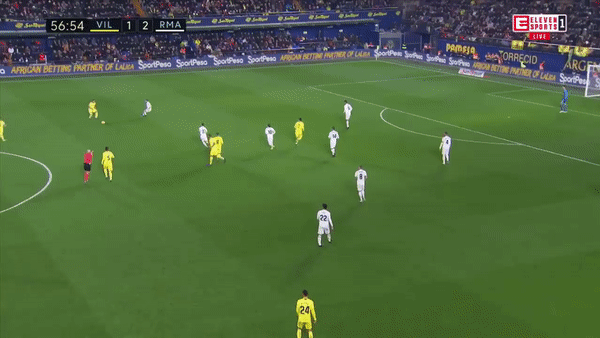 Ideally, you would want Caseres or someone else of a similar mold to be paired with a midfielder who was more of a passing hub, sort of like Lucas Torreira getting to play with Granit Xhaka and Matteo Guendouzi at Arsenal. He wouldn’t have to be burdened with unlocking defenses, and he could contribute in attack as more of a cog in a well oiled machine through recycling play, having positional awareness, and the occasional great pass. One player who’s been mildly linked to Tottenham and would have a good chance of having immediate production along with future upside is Amadou Diawara out of Napoli. Diawara has not played much for Napoli over the past three seasons, but a lot of that is due to Napoli having a bunch of really talented midfielders that they could rely on. There’s a good chance that Diawara has been more of a victim of circumstances, and he just needs to find a good club that will give him consistent minutes.
Ideally, you would want Caseres or someone else of a similar mold to be paired with a midfielder who was more of a passing hub, sort of like Lucas Torreira getting to play with Granit Xhaka and Matteo Guendouzi at Arsenal. He wouldn’t have to be burdened with unlocking defenses, and he could contribute in attack as more of a cog in a well oiled machine through recycling play, having positional awareness, and the occasional great pass. One player who’s been mildly linked to Tottenham and would have a good chance of having immediate production along with future upside is Amadou Diawara out of Napoli. Diawara has not played much for Napoli over the past three seasons, but a lot of that is due to Napoli having a bunch of really talented midfielders that they could rely on. There’s a good chance that Diawara has been more of a victim of circumstances, and he just needs to find a good club that will give him consistent minutes. 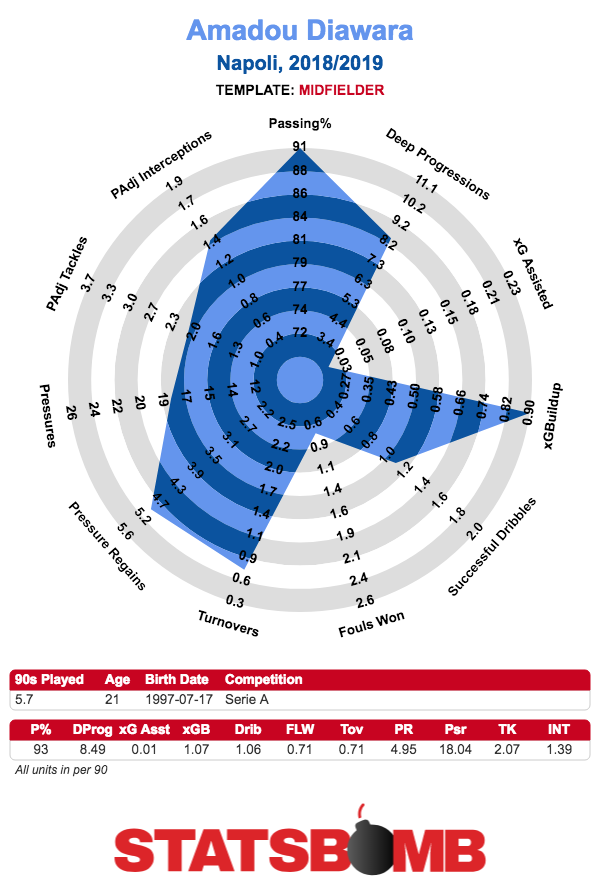 Diawara fits a lot of the requirements for the modern day defensive midfielder. He uses his intelligence and positional awareness to rack up interceptions and tackles. On offense, he is technically sound with a good understanding of his surroundings both on the ball and off of it. He makes quick decisions with his passing even while under pressure, so there’s no stuttering with trying to get the ball out of his feet. He’s not afraid to attempt vertical passes between the lines or even attempt long balls when teammates make off-ball runs.
Diawara fits a lot of the requirements for the modern day defensive midfielder. He uses his intelligence and positional awareness to rack up interceptions and tackles. On offense, he is technically sound with a good understanding of his surroundings both on the ball and off of it. He makes quick decisions with his passing even while under pressure, so there’s no stuttering with trying to get the ball out of his feet. He’s not afraid to attempt vertical passes between the lines or even attempt long balls when teammates make off-ball runs. 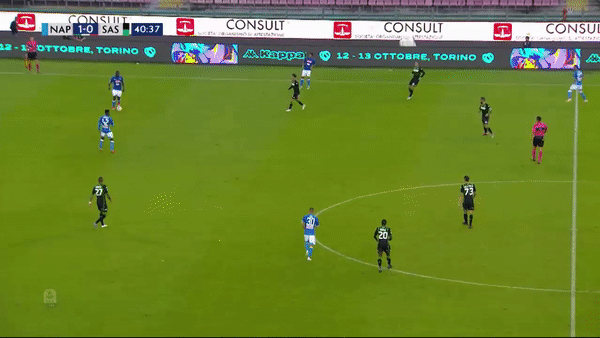 Even though Diawara has barely played over 2000 minutes spread across three seasons in Napoli, his skillset is diverse enough that he should be able to fit well with Spurs’ style of play. Perhaps the only way Spurs would be able to make a deal with Napoli would be a loan and option to buy, but it would be in their interest to pursue a move for Diawara as long as the possibility remains on the table.
Even though Diawara has barely played over 2000 minutes spread across three seasons in Napoli, his skillset is diverse enough that he should be able to fit well with Spurs’ style of play. Perhaps the only way Spurs would be able to make a deal with Napoli would be a loan and option to buy, but it would be in their interest to pursue a move for Diawara as long as the possibility remains on the table.
Fullback
In contrast to the midfield, it’s not quite as hard to find young fullbacks who could be upgrades on what Spurs currently have on the squad. A lot of that is due to Spurs’s fullbacks being a far cry from the level established by Kyle Walker and Danny Rose during the 2016-17 season when they were arguably the best duo in England. Fullback was once a strong part of Spurs approach, and it allowed them the flexibility to switch formations and styles, but now it’s become more of a source of frustration. As is customary with Ligue 1, there are several young fullbacks that have played at a high enough to warrant further consideration for Spurs. Youcef Atal has been electric in his first season in France and though Spurs do have a glut of right-backs in Aurier, Trippier, and Kyle Walker-Peters, he’s such a tantalizing young talent that he would be worth trying to acquire and he won’t cost an exorbitant amount of money. Going down the table in Ligue 1 and you’ll find other young right backs who have been productive like Enock Kwateng and Valentin Rosier. 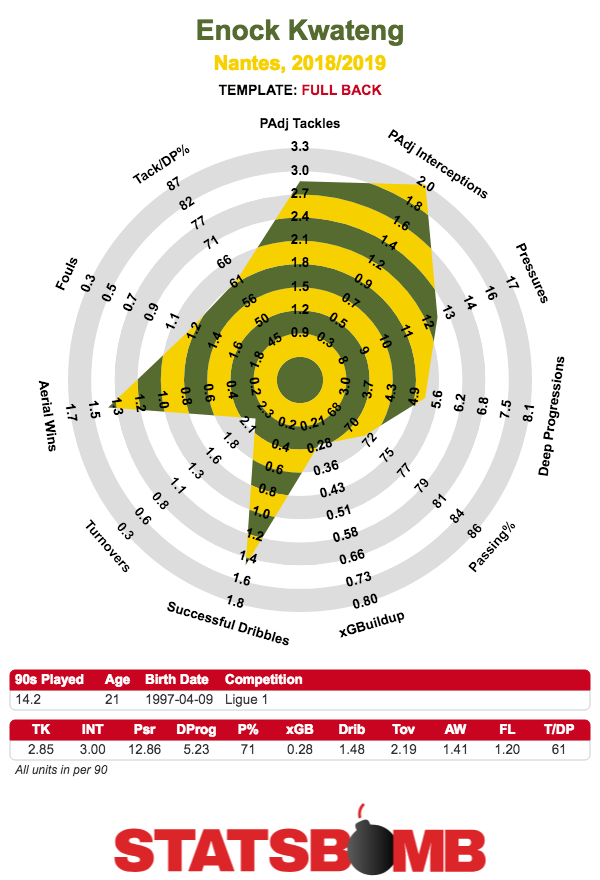
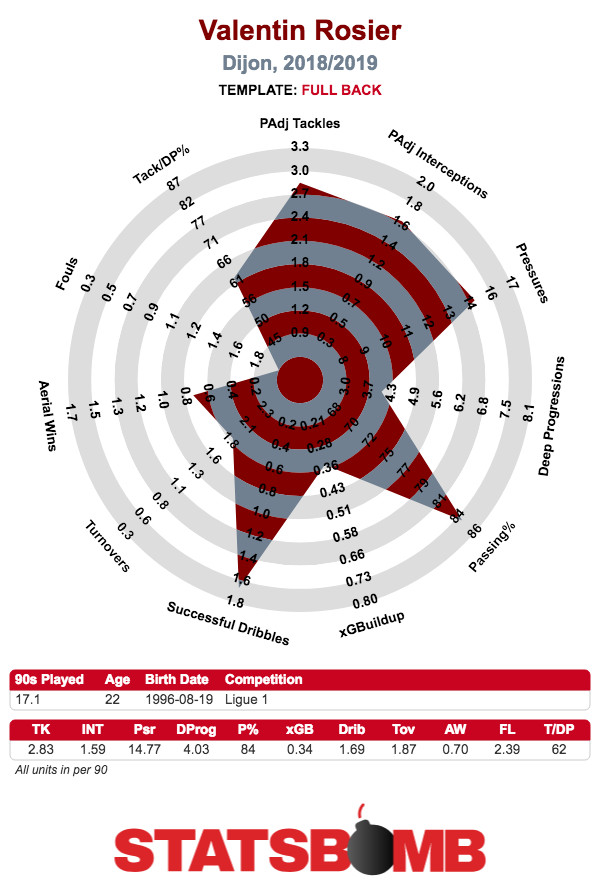 On the left side is perhaps where Spurs are a bit more concerned with getting a young talent right away. Ferland Mendy would be an obvious choice given that he’s improved from what was a strong debut season at Lyon and he has the combination of athleticism and passing needed to play at the highest level, but he’s someone who would probably be more plausible to get in the summer rather than January. In the event that Mendy is unavailable, Fode Ballo-Toure could be a viable alternative given the improvements he’s made and Lille possibly acquiescing to a move given their history of selling players to help their financial books.
On the left side is perhaps where Spurs are a bit more concerned with getting a young talent right away. Ferland Mendy would be an obvious choice given that he’s improved from what was a strong debut season at Lyon and he has the combination of athleticism and passing needed to play at the highest level, but he’s someone who would probably be more plausible to get in the summer rather than January. In the event that Mendy is unavailable, Fode Ballo-Toure could be a viable alternative given the improvements he’s made and Lille possibly acquiescing to a move given their history of selling players to help their financial books. 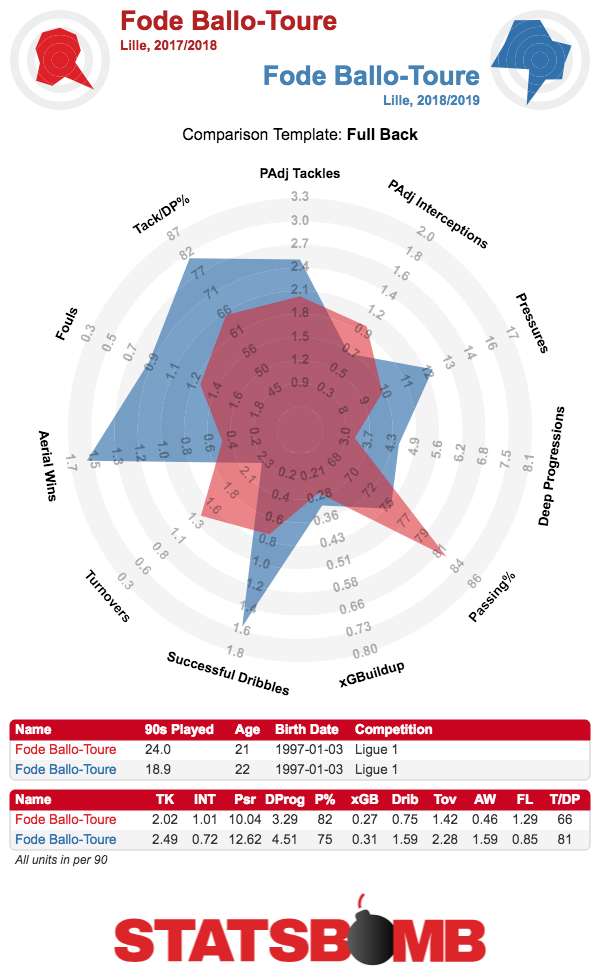 In comparison to players like Atal or Mendy, Ballo-Toure isn’t quite as dynamic on the ball. This isn’t to say that he’s a liability attacking. Ballo-Toure can make good passes whenever the wide left forward makes runs from the left halfspace to the left wing. He has the mobility to make overlapping and underlapping runs to help create space for a teammate, and he’s even sprung up in the wide left area of the penalty box every once in a while to create cutback opportunities. Defensively, Ballo-Toure has good instincts. He doesn’t over extend himself when trying to defend in isolation situations, and when he does run a fair distance to gamble with defensive actions, he’s done alright in that department.
In comparison to players like Atal or Mendy, Ballo-Toure isn’t quite as dynamic on the ball. This isn’t to say that he’s a liability attacking. Ballo-Toure can make good passes whenever the wide left forward makes runs from the left halfspace to the left wing. He has the mobility to make overlapping and underlapping runs to help create space for a teammate, and he’s even sprung up in the wide left area of the penalty box every once in a while to create cutback opportunities. Defensively, Ballo-Toure has good instincts. He doesn’t over extend himself when trying to defend in isolation situations, and when he does run a fair distance to gamble with defensive actions, he’s done alright in that department. 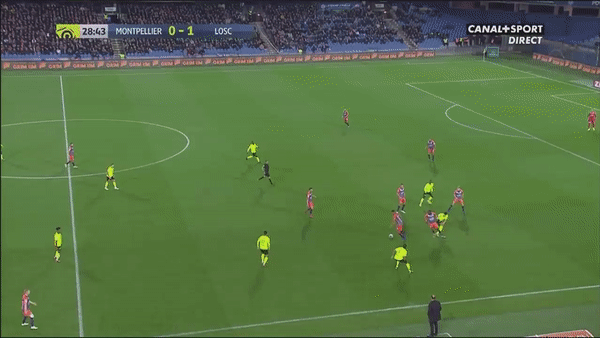 Spurs are at an interesting point in their cycle.The core of their club has largely stayed intact over the past 3-4 years, and while they were once viewed as having a young squad with room to grow during the beginning years of Pochettino’s reign, now they’ve turned into a peak age squad as their average age (weighted by minutes) is bang on with the league average at 26.9. Their attempts at supplementing their core have come with mixed results. While they’ve had their successes, they’ve also had a number of moves that didn’t work out and the odds of them working out weren’t high to begin with. Despite the fair criticisms that can be levied at their approach to transfers, Spurs have continued to punch above their weight over the past three seasons by finishing in the top 4 despite having finances that would suggest otherwise. This has been the most successful stretch for Spurs in their modern history, but without some youthful injection into the squad as soon as possible, they run the risk of becoming too stale. Header Image courtesy of the Press Association
Spurs are at an interesting point in their cycle.The core of their club has largely stayed intact over the past 3-4 years, and while they were once viewed as having a young squad with room to grow during the beginning years of Pochettino’s reign, now they’ve turned into a peak age squad as their average age (weighted by minutes) is bang on with the league average at 26.9. Their attempts at supplementing their core have come with mixed results. While they’ve had their successes, they’ve also had a number of moves that didn’t work out and the odds of them working out weren’t high to begin with. Despite the fair criticisms that can be levied at their approach to transfers, Spurs have continued to punch above their weight over the past three seasons by finishing in the top 4 despite having finances that would suggest otherwise. This has been the most successful stretch for Spurs in their modern history, but without some youthful injection into the squad as soon as possible, they run the risk of becoming too stale. Header Image courtesy of the Press Association
